Spatial Assessment of Ecotourism Development Suitability Incorporating Carrying Capacity in the Yellow River Estuary National Park
Abstract
1. Introduction
2. Materials and Methods
2.1. Study Area
2.2. Dataset
2.3. Methodology
2.3.1. Theoretical Framework
2.3.2. Construction of Evaluation Index System
2.3.3. Integrated Approach of EECC and EDS
3. Results
3.1. Evaluation of EECC
3.1.1. Ecological Environment
3.1.2. Tourism Resources
3.1.3. Socio-Economic
3.1.4. Comprehensive Evaluation of the EECC
3.2. Evaluation of EDS
3.2.1. Natural Endowments
3.2.2. Biodiversity Conservation Significance
3.2.3. Natural Hazard Risk
3.2.4. Comprehensive Evaluation of the EDS
4. Discussion
4.1. Core Findings and Significance of the Assessment
4.2. The Land–Sea Coordination Mechanism in Ecotourism Development
4.3. Comparison with Previous Studies and Innovations
4.4. Management Implications and Study Limitations
5. Conclusions
- The EECC and EDS evaluation framework was constructed. The EECC was evaluated across three subsystems: ecological environment, tourism resources, and socio-economic factors. The evaluation system for the EDS in the YRENP was constructed by overlaying indicators of natural endowments, biodiversity conservation significance, and natural hazard risks. Spatial quantification assessments and evaluation criteria have been conducted for each indicator. The weights of each system layer and each indicator were determined through the AHP method.
- The EECC tiers demonstrated progressive decline: from high to low, accounting for 8%, 15%, 21%, 25%, and 32% of the total area, respectively. Terrestrial areas exhibited superior performance due to effective ecological conservation and tourism infrastructure. Marine zones showed constrained capacity—high-capacity areas confined mainly to the coastal regions.
- The EDS grades were distributed across 26%, 21%, 24%, 15%, and 14% within the YRENP. The southern section showed a clear advantage over the northern section, with high-suitability zones demonstrating concentrated spatial clustering. The EDS in the sea area was slightly higher than that of the land areas. High-suitability zones were concentrated in coastal regions, while terrestrial suitability showed a seaward-increasing gradient.
Supplementary Materials
Author Contributions
Funding
Institutional Review Board Statement
Informed Consent Statement
Data Availability Statement
Conflicts of Interest
Appendix A
| Data Type | Year | Source |
|---|---|---|
| Land Use | 2020 | Resources and Environment Science and Data Center, Chinese Academy of Sciences |
| NDVI | 2020 | Geospatial Data Cloud |
| DEM | 2020 | Geospatial Data Cloud |
| Sentinel-1 SAR Imagery | 2021 | European Space Agency |
| Coastal Geomorphology | 2021 | China’s Third National Land Survey |
| Temperature Data | 2021 | Dongying Statistical Yearbook (2021) |
| Protected Species Distribution | 2021 | Master Plan for Yellow River Estuary National Park (2021–2035) |
| Bathymetric Model | 2022 | National Oceanic and Atmospheric Administration (NOAA) |
| Tourism Facilities/resources; Road Network and Ports | 2021 | Master Plan for Yellow River Estuary National Park (2021–2035) |
| Night-time Light | 2022 | National Oceanic and Atmospheric Administration (NOAA) |
| Index | Break Values | Threshold Sources | ||||
|---|---|---|---|---|---|---|
| I | II | III | IV | V | ||
| BAI | ≤20 | 20–35 | 35–50 | 50–70 | >70 | National Standards |
| Biodiversity Index | ≤1.82 | 1.82–1.98 | 1.98–2.17 | 2.17–2.36 | >2.36 | Natural Breaks |
| Vegetation Coverage | 0–0.25 | 0.26–0.50 | 0.51–0.70 | 0.71–0.85 | 0.86–1 | National Standards |
| River Network Density | ≤0.19 | 0.19–0.43 | 0.43–0.66 | 0.66–0.97 | >0.97 | Natural Breaks |
| Tourism Facility Capacity | ≤0.002 | 0.002–0.007 | 0.007–0.011 | 0.011–0.015 | >0.015 | Natural Breaks |
| Tourism Resources Attractiveness | >20 | 10–20 | 5–10 | 2–5 | ≤2 | Analogous Regional Benchmarks |
| Tourism Resources Abundance | ≤0.001 | 0.001–0.003 | 0.003–0.005 | 0.005–0.007 | >0.007 | Natural Breaks |
| Road Network Density | ≤1.58 | 1.58–8.71 | 8.71–21.45 | 21.45–37.35 | >37.35 | Natural Breaks |
| Transportation Accessibility (land) | ≤0.011 | 0.011–0.019 | 0.019–0.028 | 0.028–0.039 | >0.039 | Analogous Regional Benchmarks |
| Transportation Accessibility (sea) | ≤2 | 2–5 | 5–9 | 9–15 | >15 | Analogous Regional Benchmarks |
| Economic Development Level | ≤0.26 | 0.26–0.72 | 0.72–1.64 | 1.64–5.47 | >5.47 | Natural Breaks |
| Slope | >25° | 15–25° | 6–15° | 2–6° | ≤2° | National Standards |
| Elevation | / | / | <0 | / | ≥0 | Distribution Diagnostics |
| Water Depth | 16.86–27.51 | 11.60–16.86 | 8.49–11.60 | 4.06–8.49 | 0–4.06 | Natural Breaks |
| Seawater Quality | 34.22–40.24 | 40.24–46.75 | 46.75–49.86 | 49.86–53.75 | 53.75–59.00 | Natural Breaks |
| THI | <35, ≥85 | 35–40, 80–85 | 40–45, 75–80 | 45–50, 70–75 | 50–70 | National Standards |
| Density of Protect-ed Species | ≥0.142 | 0.085–0.142 | 0.045–0.085 | 0.016–0.045 | <0.016 | Natural Breaks |
| Ecosystem Significance | swamp wetlands, reeds, alkali reeds | river basins or shallow seas, tidal flats | reservoirs and ponds | arable land, aquaculture ponds, salt fields | urban land, bare land | National Standards |
| Coastal Erosion Sensitivity | Silt-mud shorelines | / | Ecologically restored shorelines | / | Artificial shorelines | Analogous Regional Benchmarks |
| Geological Disaster Risk | <−0.057 | −0.057~−0.033 | −0.033~−0.013 | −0.013~0.009 | 0.009~0.117 | Natural Breaks |
References
- Dudley, N. Guidelines for Applying Protected Area Management Categories; IUCN: Gland, Switzerland, 2008; 86p. [Google Scholar]
- Ma, B.; Zeng, W.; Xie, Y.; Wang, Z.; Hu, G.; Li, Q.; Cao, R.; Zhuo, Y.; Zhang, T. Boundary delineation and grading functional zoning of Sanjiangyuan National Park based on biodiversity importance evaluations. Sci. Total Environ. 2022, 825, 154068. [Google Scholar] [CrossRef]
- Jiang, M.; Wang, Z.; Zhu, G.; Tao, S.; Zhou, H. Chinese nature reserve classification standard based on IUCN protected area categories. Rural Ecol. Environ. 2004, 20, 1–6, (In Chinese with English Abstract). [Google Scholar]
- Xie, Y. Comparison and reference of nature reserves in China and IUCN protected area management categories. World Environ. 2016, S1, 53–56, (In Chinese with English Abstract). [Google Scholar]
- Ceballos-Lascurain, H. The future of ecotourism. Mex. J. 1987, 2, 13–14. [Google Scholar]
- Buckley, R. A framework for ecotourism. Ann. Tour. Res. 1994, 21, 661–669. [Google Scholar] [CrossRef]
- Ross, S.; Wall, G. Ecotourism: Towards congruence between theory and practice. Tour. Manag. 1999, 20, 123–132. [Google Scholar] [CrossRef]
- Donohoe, H.M.; Needham, R.D. Ecotourism: The evolving contemporary definition. J. Ecotour. 2006, 5, 192–210. [Google Scholar] [CrossRef]
- Sobhani, P.; Esmaeilzadeh, H.; Wolf, I.D.; Marcu, M.V.; Lück, M.; Sadeghi, S.M.M. Strategies to manage ecotourism sustainably: Insights from a SWOT-ANP analysis and IUCN guidelines. Sustainability 2023, 15, 11013. [Google Scholar] [CrossRef]
- Abuhay, T.; Teshome, E.; Mulu, G. A tale of duality: Community perceptions towards the ecotourism impacts on Simien Mountains National Park, Ethiopia. Reg. Sustain. 2023, 4, 453–464. [Google Scholar] [CrossRef]
- Arrow, K.; Bolin, B.; Costanza, R.; Dasgupta, P.; Folke, C.; Holling, C.S.; Jansson, B.-O.; Levin, S.; Mäler, K.-G.; Perrings, C.; et al. Economic growth, carrying capacity, and the environment. Ecol. Econ. 1995, 15, 91–95. [Google Scholar] [CrossRef]
- Cupul-Magaña, A.L.; Rodríguez-Troncoso, A.P. Tourist carrying capacity at Islas Marietas National Park: An essential tool to protect the coral community. Appl. Geogr. 2017, 88, 15–23. [Google Scholar] [CrossRef]
- Ma, P.; Ye, G.; Peng, X.; Liu, J.; Qi, J.; Jia, S. Development of an index system for evaluation of ecological carrying capacity of marine ecosystems. Ocean Coast. Manag. 2017, 144, 23–30. [Google Scholar] [CrossRef]
- de Sousa, R.C.; Pereira, L.C.C.; da Costa, R.M.; Jiménez, J.A. Management of estuarine beaches on the Amazon coast through the application of recreational carrying capacity indices. Tour. Manag. 2017, 59, 216–225. [Google Scholar] [CrossRef]
- Canestrelli, E.; Costa, P. Tourist carrying capacity: A fuzzy approach. Ann. Tour. Res. 1991, 18, 295–311. [Google Scholar] [CrossRef]
- Schwartz, Z.; Stewart, W.; Backman, E. Visitation at capacity-constrained tourist destinations: Exploring revenue management at a national park. Tour. Manag. 2012, 33, 500–508. [Google Scholar] [CrossRef]
- Manning, R. Parks and Carrying Capacity: Commons Without Tragedy; Island Press: Washington, DC, USA, 2007; pp. 23–28. [Google Scholar]
- Wang, J.; Huang, X.; Gong, Z.; Cao, K. Dynamic assessment of tourism carrying capacity and its impacts on tourism economic growth in urban tourism destinations in China. J. Destin. Mark. Manag. 2020, 15, 100383. [Google Scholar] [CrossRef]
- Corbau, C.; Benedetto, G.; Congiatu, P.P.; Simeoni, U.; Carboni, D. Tourism analysis at Asinara Island (Italy): Carrying capacity and web evaluations in two pocket beaches. Ocean Coast. Manag. 2019, 169, 27–36. [Google Scholar] [CrossRef]
- Chen, C.L.; Bau, Y.P. Establishing a multi-criteria evaluation structure for tourist beaches in Taiwan: A foundation for sustainable beach tourism. Ocean Coast. Manag. 2016, 121, 88–96. [Google Scholar] [CrossRef]
- Li, L.; Ye, X.J.; Wang, X.L. Evaluation of Rural Tourism Carrying Capacity Based on Ecological Footprint Model. Wirel. Commun. Mob. Comput. 2022, 2022, 4796908. [Google Scholar] [CrossRef]
- Lobo, H.A.S.; Trajano, E.; Marinho, M.d.A.; Bichuette, M.E.; Scaleante, J.A.B.; Scaleante, O.A.F.; Rocha, B.N.; Laterza, F.V. Projection of tourist scenarios onto fragility maps: Framework for determination of provisional tourist carrying capacity in a Brazilian show cave. Tour. Manag. 2013, 35, 234–243. [Google Scholar] [CrossRef]
- Yang, X.P.; Weng, G.M. A study on the mechanism of coupling coordination development of tourism carrying capacity and application research. Inf. Technol. J. 2013, 12, 6229–6234. [Google Scholar] [CrossRef]
- Cisneros, M.A.H.; Sarmiento, N.V.R.; Delrieux, C.A.; Piccolo, M.C.; Perillo, G.M.E. Beach carrying capacity assessment through image processing tools for coastal management. Ocean Coast. Manag. 2016, 130, 138–147. [Google Scholar] [CrossRef]
- Yang, X.P.; Weng, G.M. A review of studies on tourism environment carrying capacity. Tour. Trib. 2019, 34, 96–105, (In Chinese with English Abstract). [Google Scholar]
- Collins, M.G.; Steiner, F.R.; Rushman, M.J. Land-use suitability analysis in the United States: Historical development and promising technological achievements. Environ. Manag. 2001, 28, 611–621. [Google Scholar] [CrossRef]
- Marull, J.; Pino, J. A land suitability index for strategic environmental assessment in metropolitan areas. Landsc. Urban Plan. 2001, 81, 200–212. [Google Scholar] [CrossRef]
- Stoms, D.M.; McDonald, J.M.; Davis, F.W. Fuzzy assessment of land suitability for scientific research reserves. Environ. Manag. 2002, 29, 545–558. [Google Scholar] [CrossRef] [PubMed]
- Huang, W. Research on the Suitability of Tourism Development for Uninhabited Islands in Qinzhou. Master’s Thesis, Guangxi University, Nanning, China, 2017. (In Chinese with English Abstract). [Google Scholar]
- Liu, Y.; Lv, X.; Qin, X.; Guo, H.; Yu, Y.; Wang, J.; Mao, G. An integrated GIS-based analysis system for land-use management of lake areas in urban fringe. Landsc. Urban Plan. 2007, 82, 233–246. [Google Scholar] [CrossRef]
- Huang, P.; Chen, Y.; Zhang, Z.W. Evaluation research on island spatial suitable zoning based on GIS: A Case Study on Lingshan Island. China Popul. Resour. Environ. 2016, 26, 145–148, (In Chinese with English Abstract). [Google Scholar]
- Withanage, N.C.; Wijesinghe, D.C.; Mishra, P.K.; Abdelrahman, K.; Mishra, V.; Fnais, M.S. An ecotourism suitability index for a world heritage city using GIS-multi criteria decision analysis techniques. Heliyon 2024, 10, e31585. [Google Scholar] [CrossRef]
- Boavida, I.; Rocha, J.; Ferreira, C.C. Exploring the impacts of future tourism development on land use/cover changes. Appl. Geogr. 2016, 77, 82–91. [Google Scholar] [CrossRef]
- Fan, J. Territorial System of Human-environment Interaction: A theoretical cornerstone for comprehensive research on formation and evolution of geographical pattern. Acta Geogr. Sin. 2018, 73, 597–607, (In Chinese with English Abstract). [Google Scholar]
- Yue, W.Z.; Wang, T.Y. Logical problems on the evaluation of resources and environment carrying capacity for territorial spatial planning. Chin. Land Sci. 2019, 33, 1–8, (In Chinese with English Abstract). [Google Scholar]
- Sheng, K.R.; Fan, J. The formation mechanism of regional function: An analysis based on the theory of Man-Earth Areal System. Econ. Geogr. 2018, 38, 11–19, (In Chinese with English Abstract). [Google Scholar]
- Wang, Y.F.; Fan, J.; Zhou, K. Territorial function optimization regionalization based on the integration of Double Evaluation. Geogr. Res. 2019, 38, 2415–2429, (In Chinese with English Abstract). [Google Scholar]
- Gao, J.Z.; An, T.T.; Shen, J.W.; Zhang, K.C.; Yin, Y.; Zhao, R.; He, G.S.; Hynes, S.; Jattak, Z.U. Development of a land-sea coordination degree index for coastal regions of China. Ocean Coast. Manag. 2022, 230, 106370. [Google Scholar] [CrossRef]
- Yue, W.Z.; Hou, B.; Ye, G.Q.; Wang, Z.W. China’s land-sea coordination practice in territorial spatial planning. Ocean Coast. Manag. 2023, 237, 106545. [Google Scholar] [CrossRef]
- Li, J.P.; Weng, G.M.; Pan, Y.; Li, C.H.; Wang, N. A scientometric review of tourism carrying capacity research: Cooperation, hotspots, and prospect. J. Clean. Prod. 2021, 325, 129278. [Google Scholar] [CrossRef]
- Dong, X.L.; Gao, S.; Xu, A.R.; Luo, Z.K.; Hu, B.B. Research on tourism carrying capacity and the coupling coordination relationships between its influencing factors: A case study of China. Sustainability 2022, 14, 15124. [Google Scholar] [CrossRef]
- Chen, Y.; Liu, S.; Ma, W.; Zhou, Q. Assessment of the carrying capacity and suitability of spatial resources and the environment and diagnosis of obstacle factors in the Yellow River Basin. Int. J. Environ. Res. Public Health 2023, 20, 3496. [Google Scholar] [CrossRef]
- Chen, G.Q.; Wang, S.F. Evaluation of urban resource environmental carrying capacity and land spatial development suitability in a semiarid area of the Yellow River Basin. Sustainability 2023, 15, 12411. [Google Scholar] [CrossRef]
- Zhou, Y.; Maumbe, B.K.; Deng, J.; Selin, S.W. Resource-based destination competitiveness evaluation using a hybrid analytic hierarchy process (AHP): The case study of West Virginia. Tour. Manag. Perspect. 2015, 15, 72–80. [Google Scholar] [CrossRef]
- Zhang, X.; Li, S. Monitoring and Analysis on Ecological Environment in Near-shore Waters of Yellow River Estuary During 2015–2020. Bull. Soil Water Conserv. 2022, 42, 139–147, (In Chinese with English Abstract). [Google Scholar]
- Niu, X.; Ni, H.; Chen, G.; Zhang, D.; Zhang, J.; Zhang, J.; Wu, J. Evaluation of ecological conservation importance of Fujian Province. Acta Ecol. Sin. 2022, 42, 1130–1141, (In Chinese with English Abstract). [Google Scholar] [CrossRef]
- Ghosh, P.; Lepcha, K. Weighted linear combination method versus grid based overlay operation method—A study for potential soil erosion susceptibility analysis of Malda district (West Bengal) in India. Egypt. J. Remote Sens. Space Sci. 2019, 22, 95–115. [Google Scholar] [CrossRef]
- Wu, A.; Zhong, Z.; Yu, S.; Sui, X.; Yao, X.; Zou, L.; Wang, T.; Bian, C.; Jiang, W. The Current Status and 20 Years of Evolution of Nutrient Structure in the Yellow River Estuary. Prog. Fish. Sci. 2024, 45, 1–13, (In Chinese with English Abstract). [Google Scholar]
- Hsiao, C.Y.; Kuo, C.M.; Tuan, C.L. Island ecological tourism: Constructing indicators of the tourist service system in the penghu national scenic area. Front. Ecol. Evol. 2021, 9, 708344. [Google Scholar] [CrossRef]
- Ning, R.R.; Wang, D.; Tian, X.P.; Zhang, Y.W.; Zhou, Z.X.; Luo, F.B. Analysis of Ground Settlement in the Yellow River Delta and Projection of Seawater Inundation. Adv. Earth Sci. 2023, 38, 296–308, (In Chinese with English Abstract). [Google Scholar]
- Harishnaika, N.; Arpitha, M.; SA, A.; Ashwini, K.S. Geospatial investigation of site suitability for ecotourism development using AHP and GIS techniques in Uttara Kannada district, Karnataka state, India. World Dev. Sustain. 2023, 3, 100114. [Google Scholar] [CrossRef]
- Huang, Q.; Zhou, C.; Li, M.C.; Ma, Y.; Hua, S. An Approach for Mapping Ecotourism Suitability Using Machine Learning: A Case Study of Zhangjiajie, China. Land 2024, 13, 1188. [Google Scholar] [CrossRef]
- Morteza, Z.; Reza, F.M.; Seddiq, M.M.; Sharareh, P.; Jamal, G. Selection of the optimal tourism site using the ANP and fuzzy TOPSIS in the framework of Integrated Coastal Zone Management: A case of Qeshm Island. Ocean Coast. Manag. 2016, 130, 179–187. [Google Scholar] [CrossRef]
- Ronizi, S.R.A.; Mokarram, M.; Negahban, S. Utilizing multi-criteria decision to determine the best location for the ecotourism in the east and central of Fars province, Iran. Land Use Policy 2020, 99, 105095. [Google Scholar] [CrossRef]
- Nino, K.; Mamo, Y.; Mengesha, G.; Kibret, K.S. GIS based ecotourism potential assessment in Munessa Shashemene Concession Forest and its surrounding area, Ethiopia. Appl. Geogr. 2017, 82, 48–58. [Google Scholar] [CrossRef]
- Shokri, M.R.; Mohammadi, M. Effects of recreational SCUBA diving on coral reefs with an emphasis on tourism suitability index and carrying capacity of reefs in Kish Island, the northern Persian Gulf. Reg. Stud. Mar. Sci. 2021, 45, 101813. [Google Scholar] [CrossRef]
- Adrianto, L.; Kurniawan, F.; Romadhon, A.; Bengen, D.G.; Sjafrie, N.D.M.; Damar, A.; Kleinertz, S. Assessing social-ecological system carrying capacity for urban small island tourism: The case of Tidung Islands, Jakarta Capital Province, Indonesia. Ocean Coast. Manag. 2021, 212, 105844. [Google Scholar] [CrossRef]
- Zeng, Y.; Filimonau, V.; Wang, L.E.; Zhong, L. The role of seasonality in assessments of conflict tendency between tourism development and ecological preservation in protected areas: The case of protected areas in China. J. Environ. Manag. 2022, 304, 114275. [Google Scholar] [CrossRef]
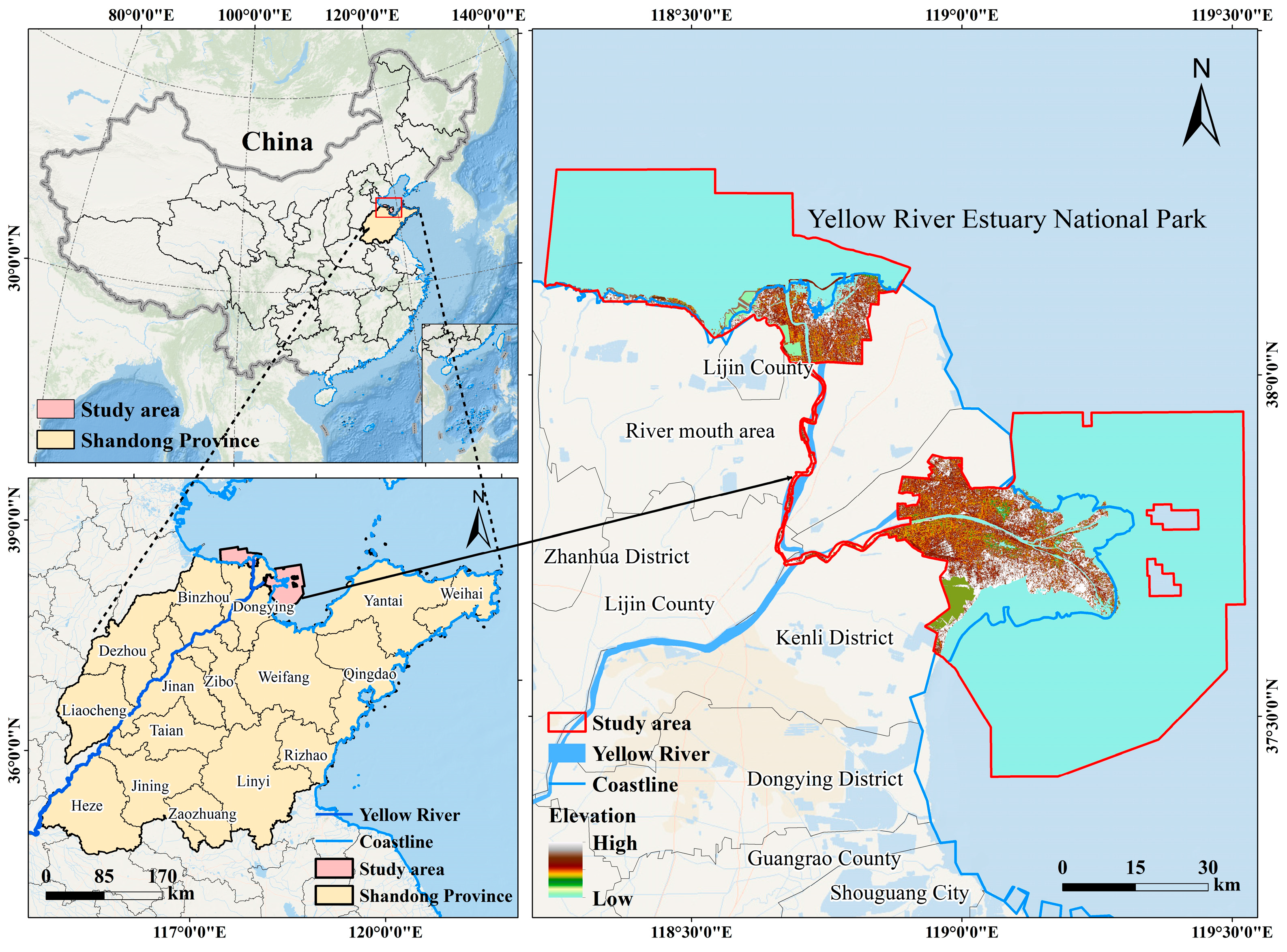
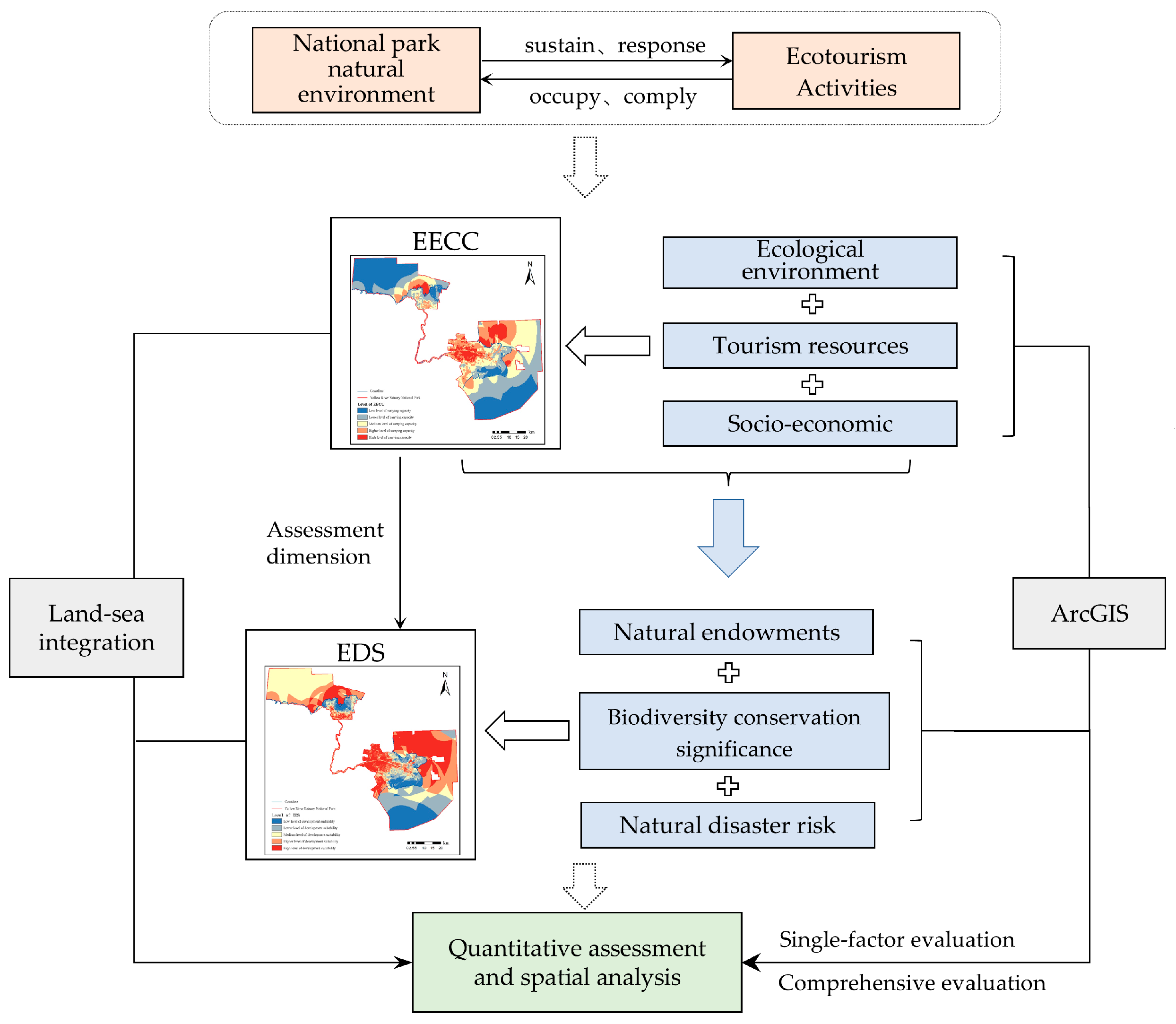
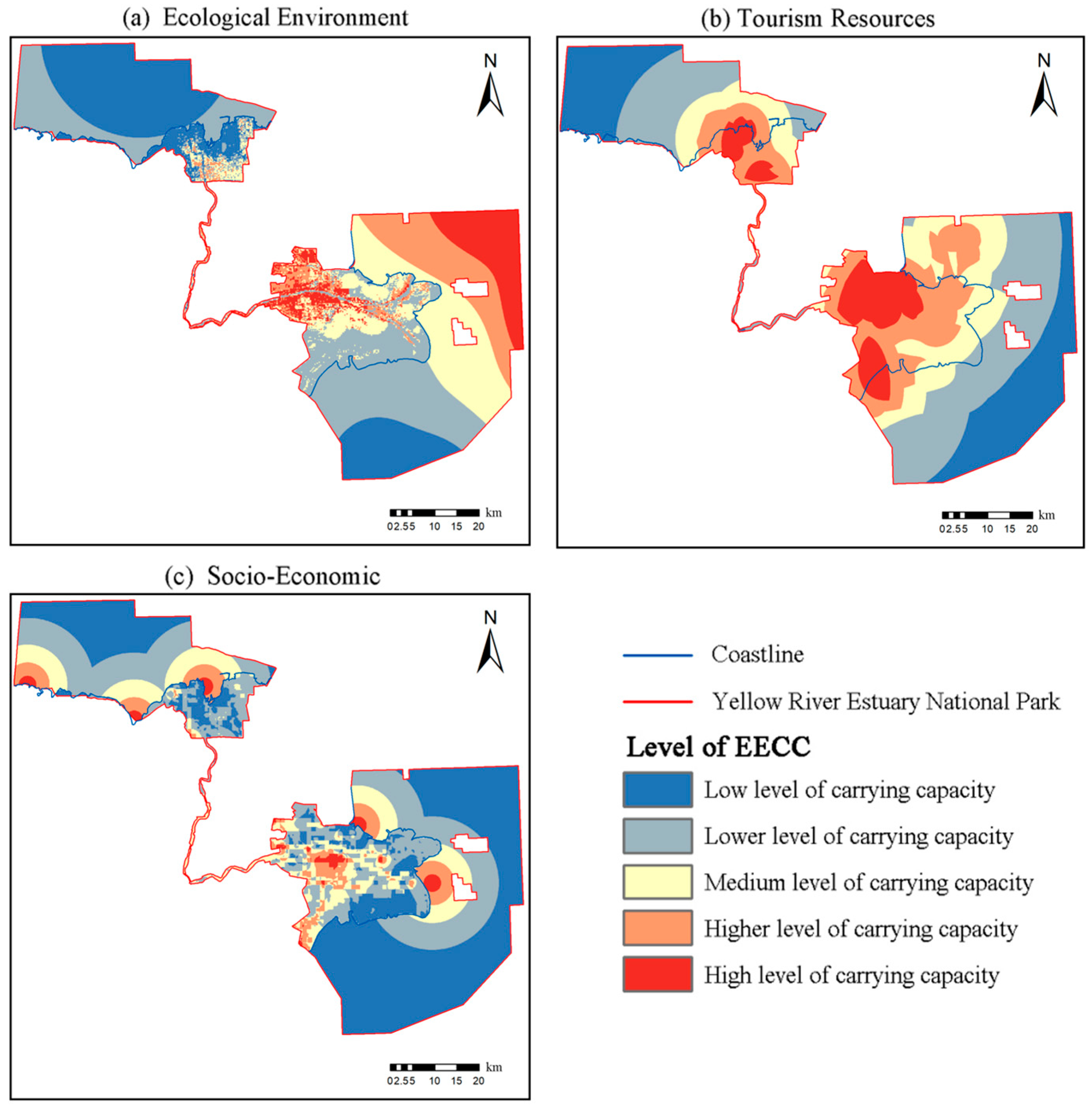
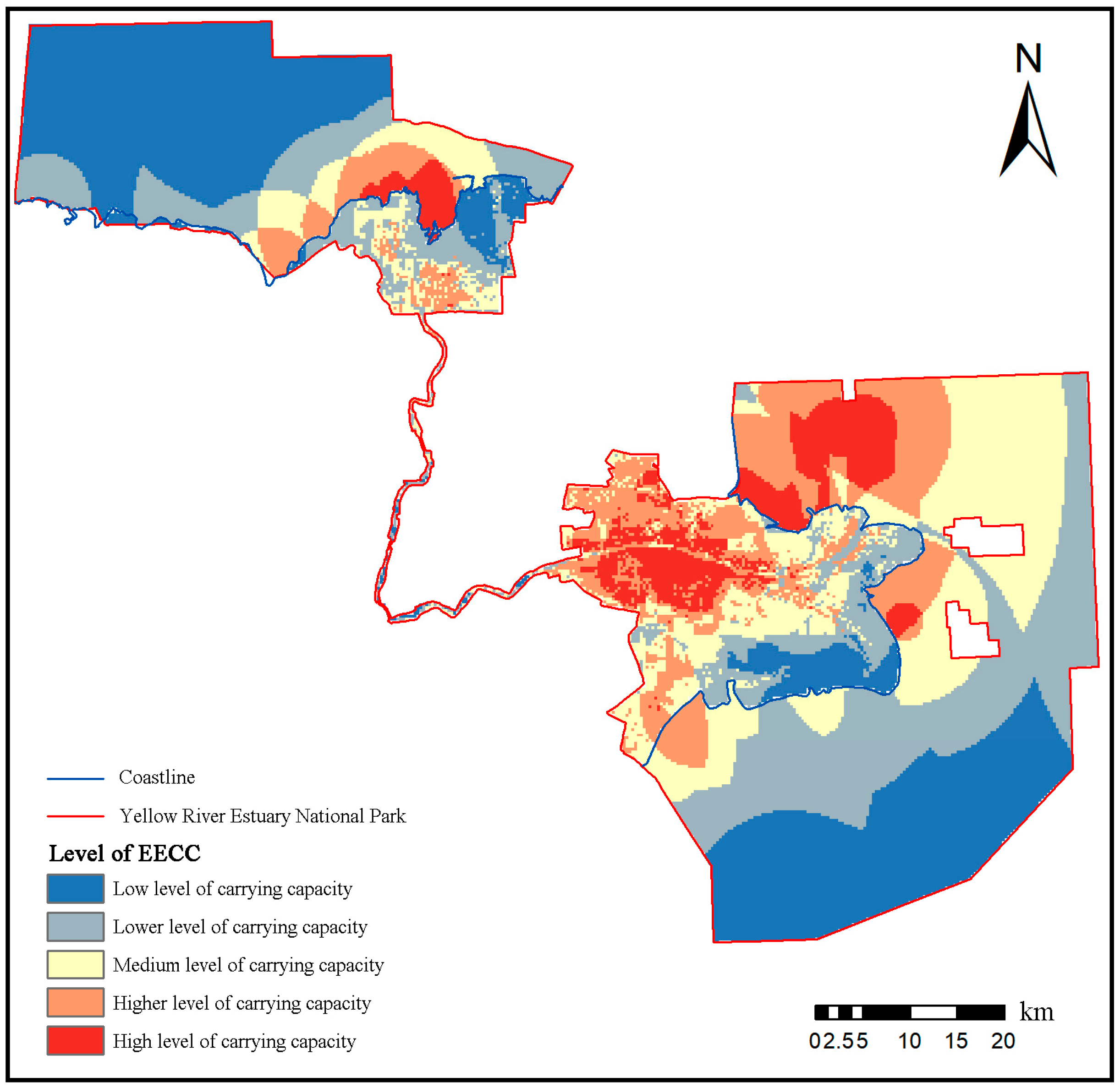

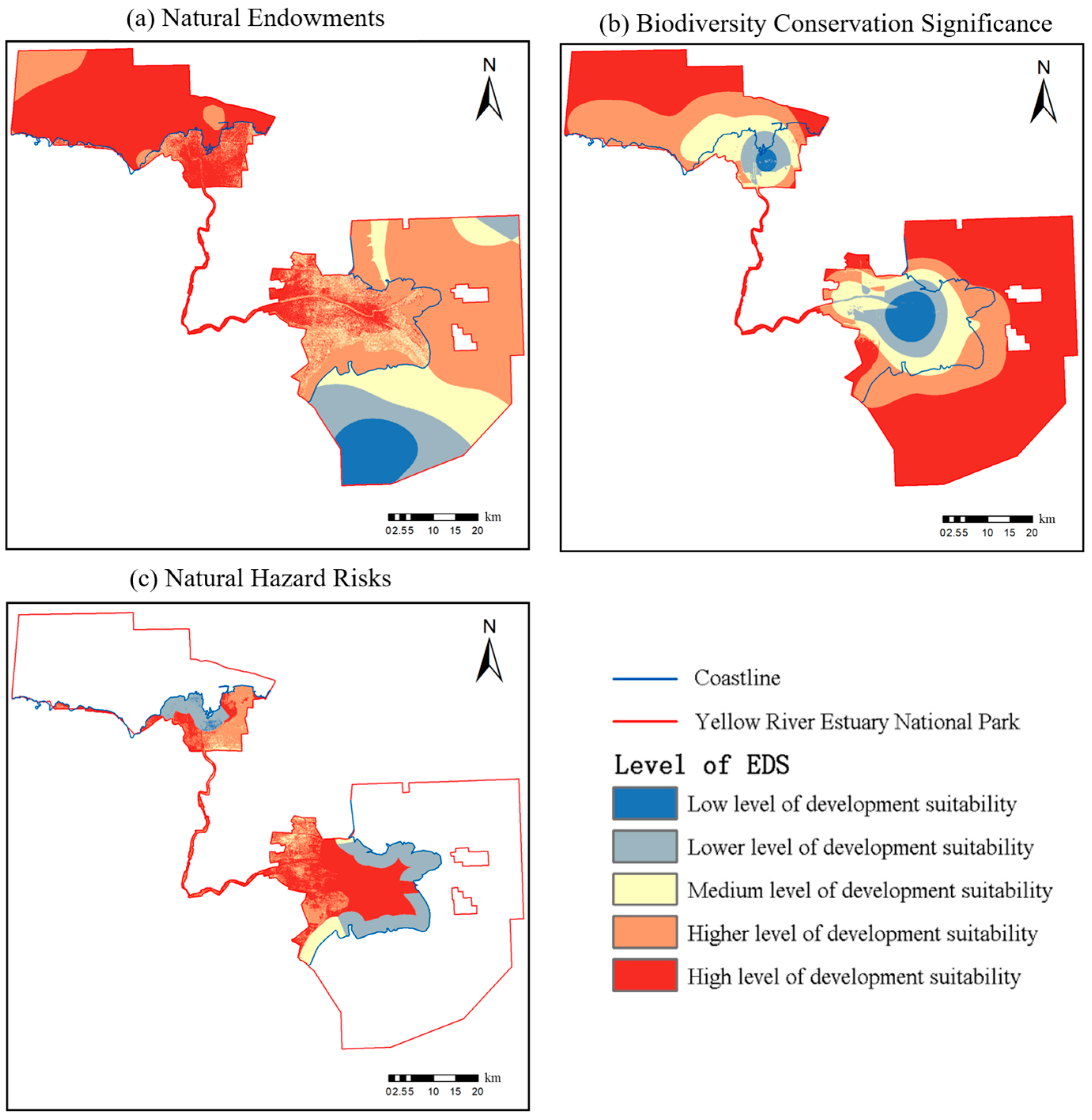
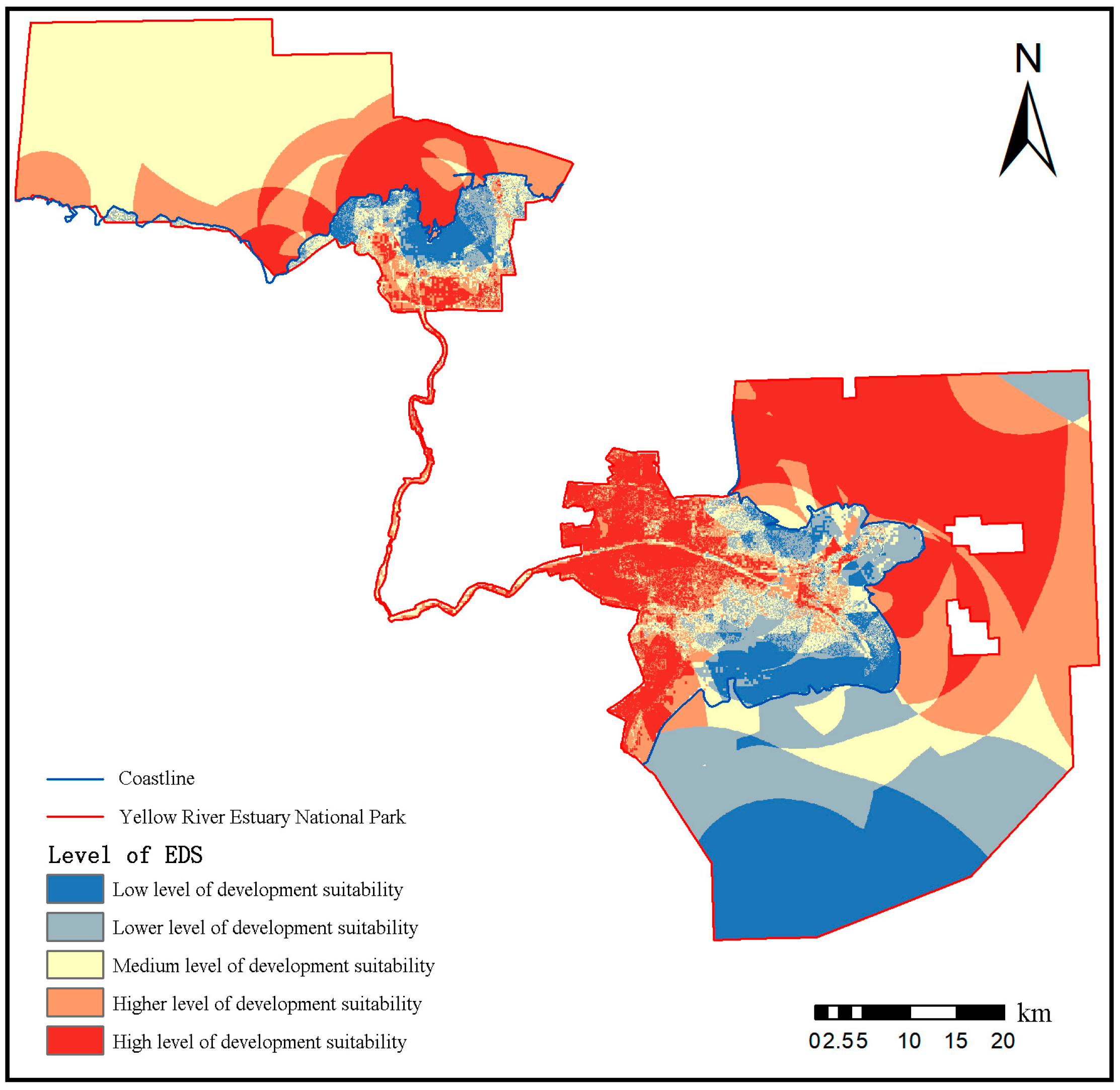
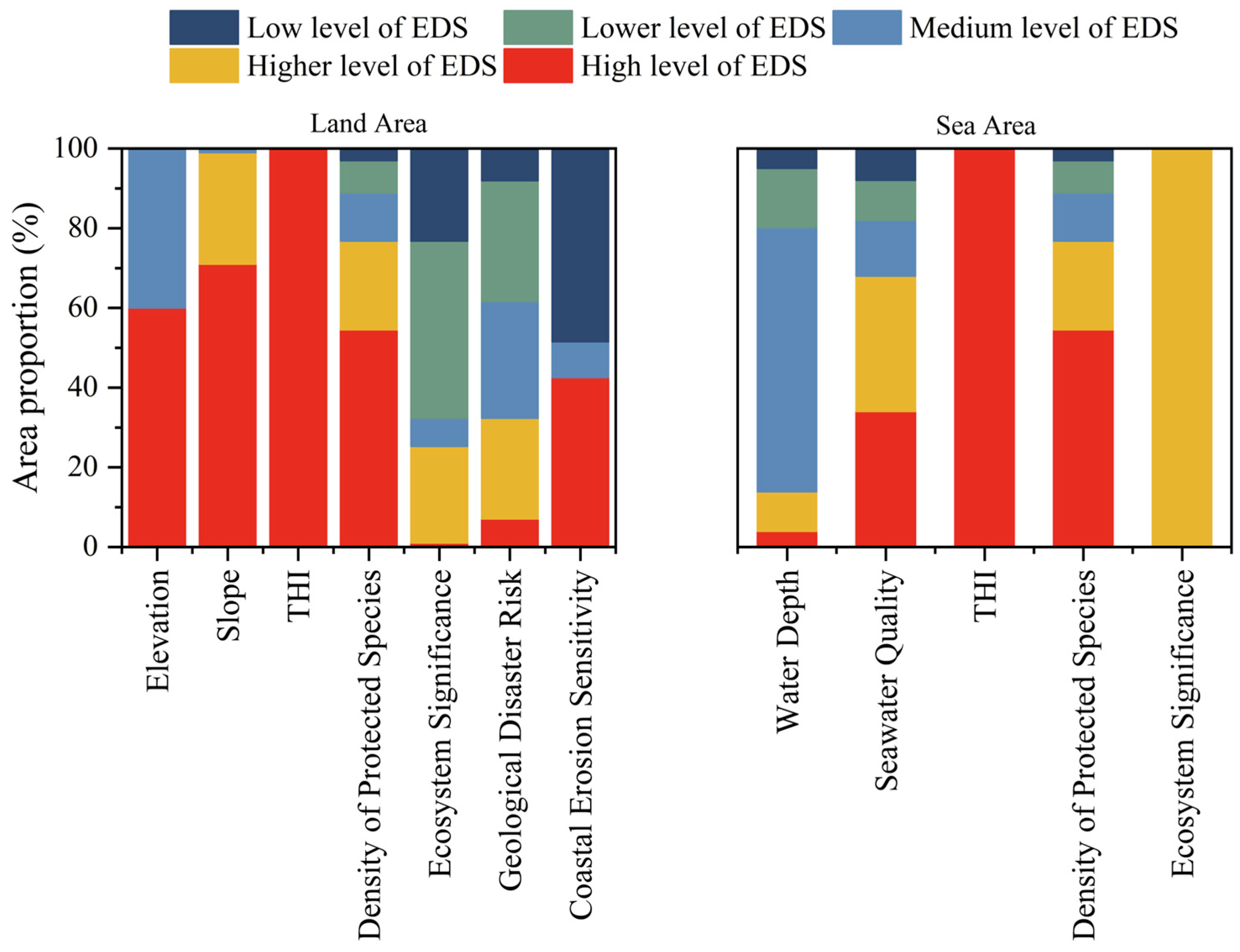
| Target | Subsystems | Index | Index Interpretation and Direction | Weights (Terrestrial) | Weights (Marine) | |
|---|---|---|---|---|---|---|
| EDS | EECC (0.451) | Ecological Environment (0.140) | Biological Abundance Index (BAI) | The differences in the number of biological species among various ecosystem types within a unit area. Positive index. | 0.071 | |
| Biodiversity Index | The diversity and richness of species within an ecosystem. Positive index. | 0.140 | ||||
| Vegetation Coverage | The percentage of the vertical projected area of vegetation per unit area. Positive index. | 0.058 | ||||
| River Network Density | The ratio of the total length of main and tributary streams to the basin area. Positive index. | 0.012 | ||||
| Tourism Resources (0.223) | Tourism Facility Capacity | The scale of ecotourism activities that can be supported by the tourism facilities. Positive index. | 0.067 | 0.067 | ||
| Tourism Resources Attractiveness | The quality of tourism resources and visitor appeal within the national park. Positive index. | 0.087 | 0.087 | |||
| Tourism Resources Abundance | The density of tourism resources. Positive index. | 0.069 | 0.069 | |||
| Socio-Economic (0.087) | Road Network Density | The density of transportation infrastructure. Positive index. | 0.026 | |||
| Transportation Accessibility | The accessibility of tourists to transportation infrastructure. Positive index. | 0.039 | 0.087 | |||
| Economic Development Level | Regional socio-economic development status. Positive index. | 0.022 | ||||
| Natural Endowments (0.197) | Elevation | Vertical height above sea level. Positive index based on regional diagnostics. | 0.018 | |||
| Slope | Maximum rate of elevation changes across a surface. Negative index. | 0.034 | ||||
| Water Depth | Depth of sea water within the national park. Negative index. | 0.039 | ||||
| Seawater Quality | Nutrient levels in seawater, expressed by N:P ratios. Positive index. | 0.127 | ||||
| Temperature-Humidity Index (THI) | A bioclimatic metric quantifying heat stress by integrating air temperature and relative humidity. Positive index. | 0.145 | 0.163 | |||
| Biodiversity Conservation Significance (0.220) | Density of Protected Species | Density of nationally protected species in China. Negative index. | 0.176 | 0.176 | ||
| Ecosystem Significance | Ecosystem importance based on wetland attributes and ecosystem service functions. Negative index. | 0.044 | 0.044 | |||
| Natural Hazard Risks (0.133) | Geological Disaster Risk | Rates of surface deformation in terrestrial areas of the national park. Negative index. | 0.053 | |||
| Coastal Erosion Sensitivity | Sensitivity of coastal geomorphological type to human activities. Negative index. | 0.080 | ||||
| Index | Spatial Quantification Methods | |
|---|---|---|
| BAI | BAI = Abio × (0.35 × Forest + 0.21 × Grassland + 0.28 × Wetland + 0.11 × Cropland + 0.04 × Construction Land + 0.01 × Unused Land)/Area | (1) |
| where Abio is the normalized coefficient of the BAI, with a reference value of 511.26. | ||
| Biodiversity Index | Utilize the Shannon–Wiener index (H′) for biodiversity characterization: | |
| (2) | ||
| where H′ is the Shannon–Wiener index; S is the total number of species in the sample; Pi is the proportion of the i-th species relative to the total number of individuals. | ||
| Vegetation Coverage | (3) | |
| where Ci is the vegetation coverage of the i-th evaluation grid cell; NDVI is the Normalized Difference Vegetation Index of the evaluation grid cell; is the NDVI value for areas that are completely bare soil or devoid of vegetation cover; is the NDVI value for pixels that are fully covered by vegetation. This study used the upper and lower bounds of the NDVI at a 0.5% confidence level. | ||
| River Network Density | Utilizing DEM data to calculate river network density, a minimum catchment area threshold of 300 km2 was set through trial-and-error comparisons. Apply the Strahler stream order classification, and the river network was determined to be divided into four levels. The calculation formula is as follows: | |
| (4) | ||
| where D is the river network density, ∑L is the total length of rivers in the area, and ∑A is the total terrestrial area of the region. | ||
| Tourism Facility Capacity | Conducting kernel density analysis on tourism facility point data derived from Point of Interest (POI) data. | |
| Tourism Resources Attractiveness | Establishing buffer zones centered on tourism resources within the YRENP, with intervals of 1 km and a maximum buffer radius of 4 km, to perform buffer zone analysis. | |
| Tourism Resources Abundance | Performing kernel density analysis on tourism resources within the YRENP, with a radius setting of 2 km. | |
| Road Network Density | Utilizing the “Create Fishnet” tool in ArcGIS to calculate the length of roads within each grid cell to determine road network density. The formula expression is identical in form to Equation (4), but represents a different physical context. | |
| where D is road network density; ∑L is the total length of roads at all levels; ∑A is the total terrestrial area of the national park. | ||
| Transportation Accessibility | For the land area, GIS-based road accessibility analysis was applied, calculating the accessibility of transportation arteries at a speed of 30 km/h. For the marine area, distance analysis tools within ArcGIS were utilized to calculate the Euclidean distance from the sea area to the wharfs. | |
| Economic Development Level | Employing night-time light data to simulate the level of economic development within the YRENP, the VIIRS night-time light data’s projection coordinate system was transformed into a Lambert projection, using bilinear resampling to eliminate interfering light factors, thereby deriving the night-time light results. | |
| Elevation | Utilizing ArcGIS to extract DEM data through masking, and subsequently processed the projected raster to obtain the elevation. | |
| Slope | Utilizing ArcGIS, processed the elevation raster data to generate a slope raster map. | |
| Water Depth | Using ArcGIS’s 3D Analyst tools to create a TIN (Triangulated Irregular Network), converted the TIN layer into raster data to obtain a depth layer, and after masking, derived the spatial distribution of water depth. | |
| Seawater Quality | Spatial distribution of nutrient N:P ratios in the YRENP marine area was generated using Kriging interpolation, with input data sourced from [45]. | |
| THI | (5) | |
| where THI is the Temperature-Humidity Index, t is air temperature in degrees Celsius, and f is relative humidity. | ||
| Density of Protected Species | Protected species distribution was processed in ArcGIS using kernel density estimation to generate a density raster of protected species. | |
| Ecosystem Significance | Using NDVI and integrating Maximum Likelihood Classification with visual interpretation, classify land-use types from remote sensing imagery. Validated the classifications in ENVI 5.6 and categorized the area into various types including urban land, river basins or shallow seas, arable land, aquaculture ponds, tidal flats, swamp wetlands, reservoirs and ponds, bare land, salt fields, reeds, and alkali reeds, then assigned values based on their ecological significance. The grading criteria are shown in Table A2 in Appendix A. | |
| Geological Disaster Risk | Leveraging InSAR (Interferometric Synthetic Aperture Radar) with Sentinel-1A ascending track remote sensing data for interferometric processing, the derived interferograms were subjected to correlation processing to determine the annual average rate of ground deformation in the YRENP. | |
| Coastal Erosion Sensitivity | The area for erosion sensitivity assessment was designated as a 3-km-wide strip landward of the coastline [46]. Various coastal geomorphological types within the study area were assigned values. The grading criteria are shown in Table A2 in Appendix A. | |
Disclaimer/Publisher’s Note: The statements, opinions and data contained in all publications are solely those of the individual author(s) and contributor(s) and not of MDPI and/or the editor(s). MDPI and/or the editor(s) disclaim responsibility for any injury to people or property resulting from any ideas, methods, instructions or products referred to in the content. |
© 2025 by the authors. Licensee MDPI, Basel, Switzerland. This article is an open access article distributed under the terms and conditions of the Creative Commons Attribution (CC BY) license (https://creativecommons.org/licenses/by/4.0/).
Share and Cite
Wang, H.; Zhang, Y.; Wang, Q.; Yu, J.; Yuan, C. Spatial Assessment of Ecotourism Development Suitability Incorporating Carrying Capacity in the Yellow River Estuary National Park. Sustainability 2025, 17, 8449. https://doi.org/10.3390/su17188449
Wang H, Zhang Y, Wang Q, Yu J, Yuan C. Spatial Assessment of Ecotourism Development Suitability Incorporating Carrying Capacity in the Yellow River Estuary National Park. Sustainability. 2025; 17(18):8449. https://doi.org/10.3390/su17188449
Chicago/Turabian StyleWang, Haoyu, Yanming Zhang, Quanbin Wang, Jing Yu, and Chunjiu Yuan. 2025. "Spatial Assessment of Ecotourism Development Suitability Incorporating Carrying Capacity in the Yellow River Estuary National Park" Sustainability 17, no. 18: 8449. https://doi.org/10.3390/su17188449
APA StyleWang, H., Zhang, Y., Wang, Q., Yu, J., & Yuan, C. (2025). Spatial Assessment of Ecotourism Development Suitability Incorporating Carrying Capacity in the Yellow River Estuary National Park. Sustainability, 17(18), 8449. https://doi.org/10.3390/su17188449






